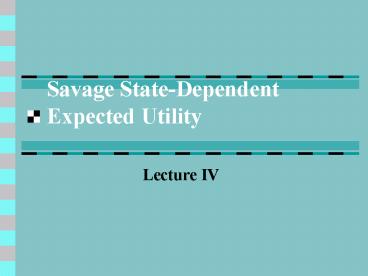Savage State-Dependent Expected Utility - PowerPoint PPT Presentation
1 / 14
Title:
Savage State-Dependent Expected Utility
Description:
Savage s state dependent expected utility Savage s subjective expected ... Cardinality assigns importance to the actual numbers. The Cardinal Coordinate ... – PowerPoint PPT presentation
Number of Views:70
Avg rating:3.0/5.0
Title: Savage State-Dependent Expected Utility
1
Savage State-Dependent Expected Utility
- Lecture IV
2
Savages state dependent expected utility
- Savages subjective expected utility theory takes
as the object of choice state dependent outcomes.
3
(No Transcript)
4
- Writing the expected utility of the gamble out,
we have - What is changing? The probability or the states?
5
- Savage proved a similar result to the von
Neumann-Morgenstern modelif agents preferences
obey certain axioms they have an expected utlity
representation through both the probabilities of
each outcome and the utility function. - Specifically, the probabilities in the expected
value framework may be endogenous.
6
Axiomatization of StateDependent Expected
Utility
- Start with some notation.
- In the statepreference format we speak of the
utility function mapping from state-space into
preferences
7
- Next, we want to introduce the notation of
replacement - when the return in state s is replaced with y.
8
- We are interested in making the comparison
- Note that c,d?RS or are two vectors of outcomes
or payoffs while y,w?R are two scalar incomes.
9
- For example, take an investment
10
- The independence axiom for state-dependent
expected utility requires that - Intuitively, the ordering remains the same if we
replace on of the states with a common payoff.
11
- Theorem 8.5.1 Assume that there are at least
three states, S? 3. Utility function u has a
state-dependent expected utility representation
iff it obeys the independence axiom.
12
Cardinal Utility Systems
- A second article Friedman and L.J. Savage (1952)
The Expected-Utility Hypothesis and the
Measurability of Utility Journal of Polictical
Economy 60(6) 46374 followed the Friedman and
Savage article we analyzed last class. This
article responded to a comment by William Baumol
that raised questions about the cardinality of
utility measures.
13
- Most of our current microeconomic theory is based
on ordinal utility measurement where the actual
levels of the utility are not important only the
order or relative rank. - Cardinality assigns importance to the actual
numbers.
14
- The Cardinal Coordinate Independence axiom is a
stronger version of the independence axiom
discussed above. - Proposition 8.6.1 Cardional coordinate
independence implies independence. - Theorem 8.6.2 Utility function u has a
state-independent expected utility representation
iff it obeys the cardinal coordinate independence
axiom.































